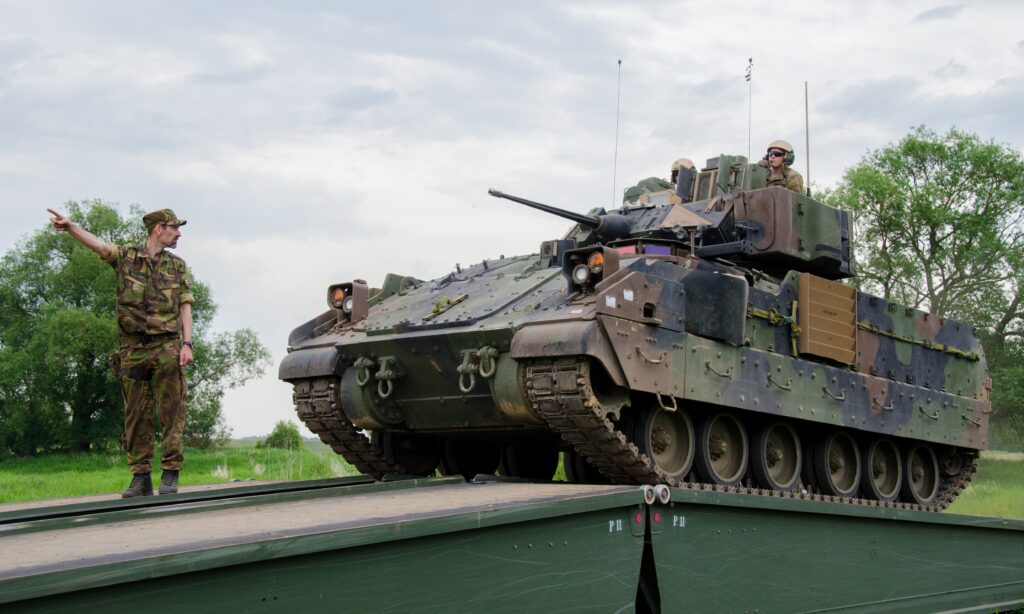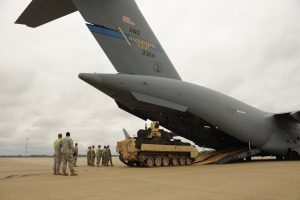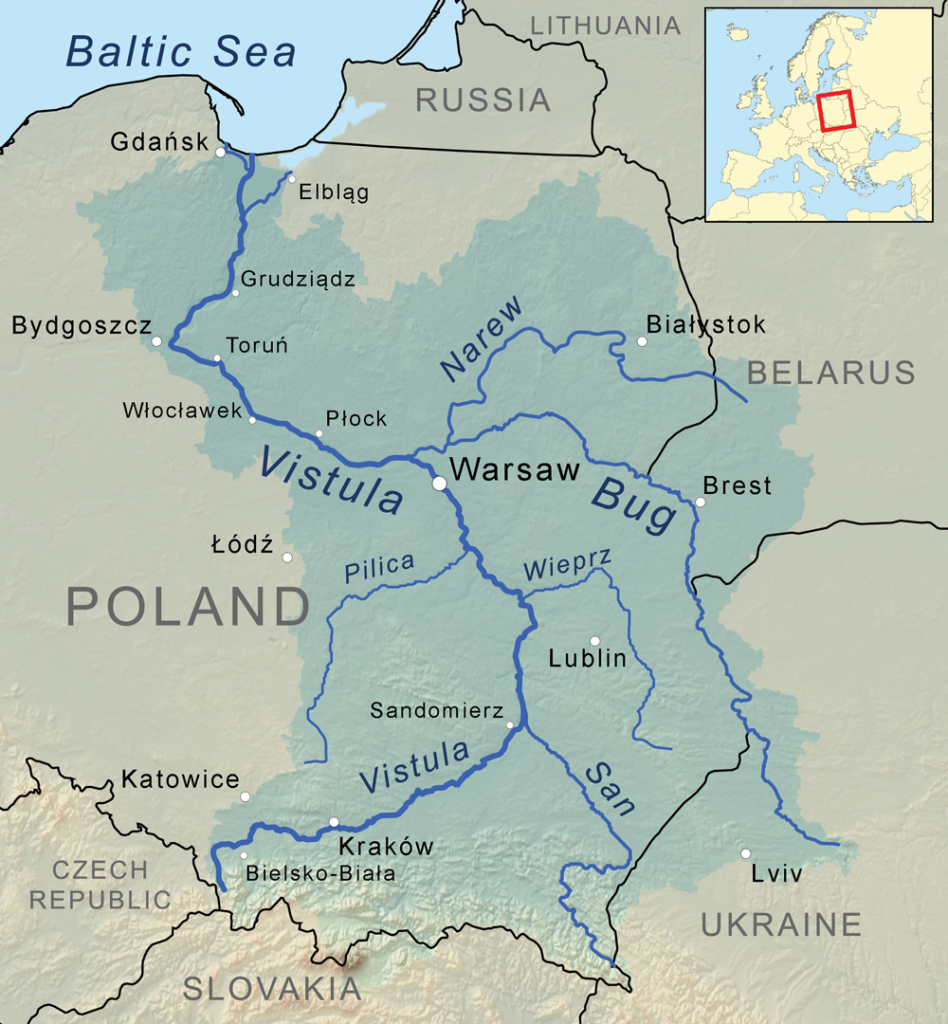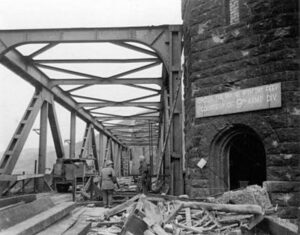
An M2 Bradley crosses a Dutch Army folding bridge. But military bridging is too short and too scarce to handle major rivers.
WASHINGTON: As the Army reboots its program to replace the 1980s-vintage Bradley Fighting Vehicle – its third attempted replacement in two decades – one crucial constraint is a little-appreciated feature of Eastern European infrastructure.
What’s that, you ask? Here’s the backstory. Unsatisfied with both potential vendors’ vehicles, the Army canceled its competition for a new Optionally Manned Fighting Vehicle last month and announced it was reassessing its requirements. By all accounts, the problem was not the sophisticated automation for which the program was named. Instead, the dilemma was the age-old tradeoff between armor and mobility.

An Army M2 Bradley drives aboard an Air National Guard C-17 transport.
The immediate problem – there’s a whole other layer we’ll get to in a moment – was strategic mobility by air. The Army wanted the OMFV to weigh about the same as the most heavily armored variants of the Bradley it’s replacing, roughly 45 tons, so the Air Force could carry two of them on a C-17 cargo jet, which would allow rapid deployment to a crisis zone. But industry couldn’t get weight down that low and make the armor protection as strong as the Army wanted for survival in a European war with Russia.
Now that the Army is rebooting the program, can they cut industry some slack on weight? After all, as much as the Army has struggled for decades to develop armored vehicles that fit Air Force C-17s and C-130s, it’s never actually deployed more than a handful by air in any real-world operation, simply because there’s not enough airlift available. As a practical matter, the overwhelming majority of the Army’s heavy equipment arrives by sea, just as it did in World War II. The way to get it there faster is to send it sooner. The Army Prepositioned Stocks program keeps entire combat brigades’ worth of vehicles in warehouses around the world, close to potential conflict zones.
Since ships and APS warehouses don’t have the same weight limits as planes – their limiting factor is often volume, not weight – can’t the Army let the Bradley replacement be as heavy as it needs to be to survive Russian weapons?
Yes, up to a point. Here’s where we get back to the infrastructure. The problem isn’t just fitting on planes. It’s also crossing bridges.

The Vistula River and its tributaries form a natural barrier to east-west movement. (Wikimedia Commons)
While the US has spent most of the century so far fighting in deserts, any war with Russia would be fought in Eastern Europe, a vast plain riven by rivers. Many of those rivers, like the Vistula, run north-south, which forces NATO forces to bring reinforcements or to retreat across bridges. And few of them can handle more than 55 tons.

Rivers of Poland. (Wikimedia Commons)
There are historical reasons for this. While Western European infrastructure was often reinforced during the Cold War to handle the weight of 60-plus-ton NATO tanks, Eastern Europe couldn’t afford to build as robustly and, in any case, only had to accommodate much lighter Soviet tanks, like the 45-ton T-72. (Many Soviet vehicles were amphibious anyway, precisely to cross the region’s rivers).
Poland in particular has many rivers and few reinforced bridges It has run afoul of EU regulators for not being able to accommodate heavy vehicles. “The infrastructure in Poland is different than in some other European countries,” warns one guide for truckers. “Many bridges are only suitable for [vehicles] with a maximum weight of 50 or sometimes 60 tonnes [55 to 66 tons US]. If the weight exceeds 60 tonnes each bridge or viaduct has to be assessed to determine whether the transport can pass over it without any problems.”
What does this mean militarily? At more than 60 tons, the M1 Abrams main battle tank and most of its NATO kindred – the British Challenger II, the German Leopard II, even the French Leclerc — are already unsafe for many bridges where the alliance most urgently needs them. Well-armed troop carriers like the M2 Bradley – Infantry Fighting Vehicles (IFVs) in military jargon – are under 50 tons, so they can cross many more bridges. That allows the mid-weight IFVs to move into position, dismount their infantry, and at least try to hold the line until the heavy tanks find a way across.

US troops on the Ludendorff Bridge over the Rhine at Remagen before it collapsed under German bombardment.
Spending billions to replace the Bradley with a new Infantry Fighting Vehicle that can’t cross most Eastern European bridges would appear to be unwise. And while Army engineers have some capability to build bridges under fire, or even deploy a short (11-meter) Joint Assault Bridge from an armored carrier in minutes, those capabilities are far too limited to cope with even one major Eastern European river.
Crossing bridges isn’t an unusual maneuver. It’s something armored units have to do all the time. In fact, throughout history, if there is only one bridge you can use to reach your objective, it becomes natural chokepoint where the enemy can kill your forces piecemeal as you cross. Such bloodbaths can become the stuff of legend, like the legendary Roman Horatius stopping the Etruscans, or Lee’s Confederates stalling Burnside at Antietam Creek, or the German Wehrmacht bombarding the last bridge at Remagen for 10 days — until it fell into the Rhine — as US troops pushed cross. Those aren’t the kind of battles the Army wants to fight in the future.
Move over FARA: General Atomics pitching new Gray Eagle version for armed scout mission
General Atomics will also showcase its Mojave demonstrator for the first time during the Army Aviation Association of America conference in Denver, a company spokesman said.


























